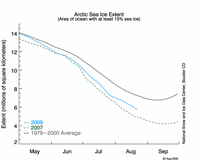
“The article captures the Zeitgeist of a growing group of climate scientists who perceive that human activities are already pushing Earth’s climate past regional tipping points,” the lead authors state. The research team headed by Tim Lenton from the University of East Anglia in Norwich, Great Britain, and Hans Joachim Schellnhuber, Director of the Potsdam Institute for Climate Impact Research (PIK) in Germany has introduced the term ‘‘tipping element’’ to describe large-scale components of the Earth system that may be pushed past critical thresholds by anthropogenic forcing. On the verge of tipping, tiny perturbations could have large long-term consequences on human and ecological systems. “Our paper has sensitized the public to the possibility of highly nonlinear reactions of Nature to human interference with the climate system,” says Hans Joachim Schellnhuber.
An example of a tipping element is the Arctic sea-ice (see figure). As sea-ice melts, it exposes a much darker ocean surface, which absorbs more radiation from the sun. This in turn amplifies the warming, decreases ice formation in winter, and causes more rapid melting in summer. The long-term trend in summer ice extent indicates a decline of 3.3 percent for the last three decades. As reported in the Tipping Elements paper, there could be a nonlinear transition to a new stable state with no arctic sea-ice during summer within a few decades. The critical threshold global mean warming may be between 0.5 to 2 degrees Celsius and could already have been passed. Earth is about to lose the cooling white reflector for arctic summer sunlight and this could enhance global warming.

“We have been living under the illusion that climate change will be a smooth process. Our paper shatters that illusion,” says Tim Lenton. Large regions of the planet may undergo profound changes in state that in some cases are rapid and often are irreversible, with impacts on many millions of people. “I guess we have added a relevant piece to the now compelling scientific evidence that one needs to confine global warming to two degrees Celsius if you wish to have a fair chance of avoiding unmanageable climate risks,” says Schellnhuber.
The researchers identified the common dynamics underlying nine of these tipping elements, including tropical monsoons, the Amazon rainforest, ocean circulation, and the great ice sheets of Greenland and West Antarctica. “This helps bring together the interests and concerns of specialists in quite different fields including climatology, ecology, oceanography and glaciology,” says Lenton. The work has profound economic and political implications and was named Research Project of the Year 2008 by the Times Higher Education newspaper.
Hans Joachim Schellnhuber had introduced the overall tipping-points concept into the scientific community. The specific research generating the paper began with a workshop at the British Embassy in Berlin in October 2005, which brought together UK and German scientists to debate and begin to identify the potential tipping points in the climate system. A process led by co-authors Elmar Kriegler and Jim Hall of eliciting responses from more international experts continued through the following year. Tim Lenton led a comprehensive review of the literature. “The greatest challenge along the way was reconciling the inputs from a diverse group of co-authors, an even wider pool of expert opinions, and a huge body of literature,” Lenton and Schellnhuber state in an interview recently published at the Thomson Reuters “Science Watch” website.
Thomson Reuters Hot Papers are derived from the ISI Web of Knowledge, the world’s largest citation environment of the highest quality scholarly literature. A published work is identified as a Hot Paper if it is less than two years old and has achieved a rate of citations in scientific journals that is markedly higher than papers of comparable type and age.
Article: Lenton, T., H. Held, E. Kriegler, J. Hall, W. Lucht, S. Rahmstorf, and H. J. Schellnhuber, 2008: Tipping elements in the Earth's climate system. Proceedings of the National Academy of Sciences, 105, 1786-1793.
Further reading:
Thomson Reuters ScienceWatch® website
http://sciencewatch.com/dr/nhp/2009/09julnhp/09julnhpLentET/
The Times Higher Education award 2008 for Research Project of the Year:
http://www.timeshighereducation.co.uk/hybrid.asp?typeCode=246&pubCode=1&navcode=98
“'Tipping points' could come this century” – Press release by the University of East Anglia
http://www.uea.ac.uk/mac/comm/media/press/2008/feb/%27Tipping+points%27+could+come+this+century
“Tipping elements in the Earth's climate system” – Press release by the Potsdam Institute for Climate Impact Research
National Snow and Ice Data Center, Arctic sea-ice extent daily image update
http://nsidc.org/arcticseaicenews/
For further information please contact the UEA or PIK press office:
PIK press office
Phone: +49 (0)331 288 25 07
E-mail: press@pik-potsdam.de
UEA press office
Phone: +44 (0)1603 59 34 96
E-mail: press@uea.ac.uk





